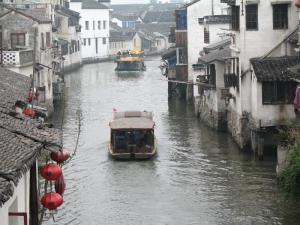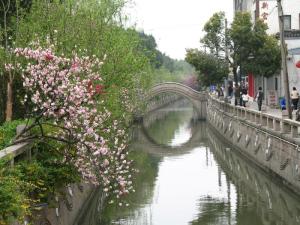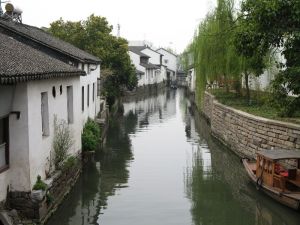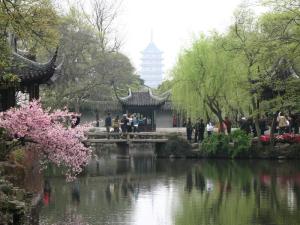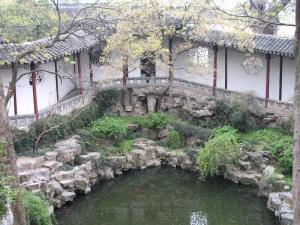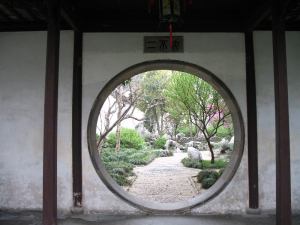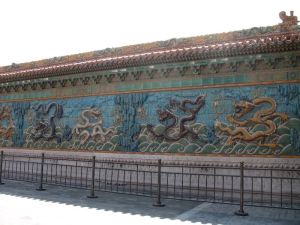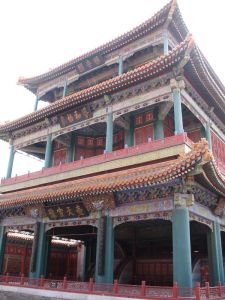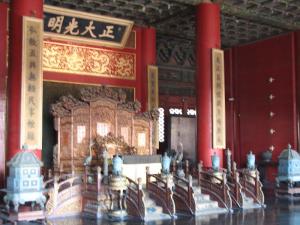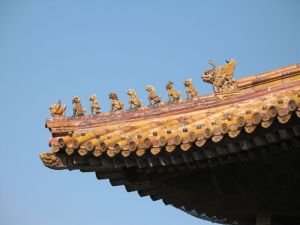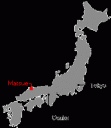I spent my last full day in China in the city of Suzhou, 45 minutes west of Shanghai by express train.
Suzhou was founded some 2,500 years ago as the capital of the state of Wu, during China’s “Spring and Autumn Period” (when separate kingdoms formed as the Zhou Dynasty gradually lost control, leading in turn to the Warring States Period). Suzhou remained the cultural center of the region until Shanghai overshadowed it in the last century or so. Today, a visitor might be tempted to call Suzhou a town rather than a city, as it doesn’t have any high rises, but it has over two million residents.
The Grand Canal passes through Suzhou, and the city is crisscrossed with many smaller canals. Marco Polo called Suzhou the Venice of the East, and although it isn’t nearly so magnificent today, it still has charming spots.
The canals vary in size and character. This one is cleaner, if perhaps less interesting.
Another small canal.
But as picturesque as its canals can be, they aren’t what brought me to Suzhou. The city’s real draw is its collection of old gardens.
Like Yuyuan in Shanghai, Suzhou’s gardens were urban homes landscaped into private paradises and sanctuaries. At one time, Suzhou had over 200 gardens. Unfortunately, far fewer remain today, but nine of the best preserved gardens are listed as UNESCO World Heritage sites. I managed to visit five of these.
The first garden I saw was the Humble Administrator’s Garden.
This is not the Humble Administrator’s Garden.
On accident, I entered Suzhou Museum, which is right next door. I had known that the museum was next to the garden, but I was tricked because the museum has two entrances – one for the museum proper and another for Prince Zhong’s Residence, an old mansion that’s now part of the museum. I soon realized my mistake, but only after I’d bought a ticket and entered. Still, two good things came out of screwing up.
One was that the residence is a fascinating historic site, although the English signage was limited. Prince Zhong was a rebel commander in the Taiping Rebellion (1850-1864). I’d never heard of the rebellion, but apparently its leader claimed to be the younger brother of Christ.
And so the residence has a chapel.
The Taiping Rebellion took place following the First Opium War, whose humiliating outcome left many Chinese people disaffected with the imperial government. The rebellion gained many supporters and escalated into a brutal civil war that killed over 20 million people. You’d think that would warrant mention in a history class, but then again, I don’t think I learned any Chinese history before college.
The second good thing about accidentally entering Suzhou Museum was that the main museum building was brand new and had really nice, clean, modern bathrooms. That’s not something you can take for granted.
Anyhow, my time was limited, so after taking a very quick look at the most interesting parts of the museum and enjoying the beautifully sanitary restroom, I moved on to my intended destination.
At all the gardens I visited, the crowds were heavy – it was the Saturday following a national holiday after all – and the best views were constantly blocked by domestic tour groups. There were occasional lulls in the flow of people, and I took pictures when I could, but the breaks didn’t necessarily happen when I was in a good place for a shot, and my digital camera still had the problem of randomly flipping its image (which began in Hong Kong and which I didn’t fix until I was back in Japan), so I don’t have many good pictures. I’ll share what I can.
This is the Humble Administrator’s Garden.
It presents a nice example of the borrowed scenery technique, using the pagoda.
I bought a book on the gardens of Suzhou while I was in the city, and it says that the Humble Administrator’s Garden was built in 1530. The book then goes on to note that the garden was later divided into three sections with different owners for each part. Before being reunited centuries later, the different sections experienced very different treatment. The central part mostly kept the original Ming Dynasty aesthetic, the western section changed to reflect late Qing Dynasty style, and the eastern section was in ruins before getting a renovation in the 1950s that didn’t really adhere to any classical style.
Maddeningly, the book never explains any of these styles. It just says that such and such a garden is an exemplar of such and such an era’s style and then leaves it at that. And since I haven’t found much information elsewhere, I can’t offer any illumination. Bah.
The next garden I visited was the Lion Grove, built around 1340.
Rock collecting was a popular pursuit among Chinese literati and the owner must have been thrilled to find this lion-like formation. I don’t know if the rock inspired the garden or if it was added later, but apparently the garden’s builder was a Buddhist monk, and Lion Grove was the name of a mountain monastery.
The garden’s most famous feature is its sprawling artificial hill, which was meant to evoke the mountain home of the original Lion Grove.
This is just a part of the maze-like rockery, which has nine paths and 11 caves. Those numbers have some sort of religious symbolism, but I don’t know what that is.
After seeing the Lion Grove, I stopped for lunch.
I ate at Deyuelou (得月楼), a 400-year-old restaurant. My food was fine, but nothing impressive, and the restaurant’s huge, modern building wasn’t particularly atmospheric. Still, I don’t dismiss Deyuelou, since it’s really meant for large groups sharing a variety of dishes. And I did eat something that I’d never eaten before and may never encounter again: I had a soup that included fried caterpillar fungus. It wasn’t bad.
From lunch, I moved on to the Master of Nets Garden, built in the 18th century on the site of a 12th century garden.
The name, my book tells me, is a tribute to another garden, the Fisherman’s Garden.
The love of unusual rocks was present here, as in all the gardens I saw.
This particular rock supposedly produces a ringing tone when struck. I didn’t test it myself, but a Chinese kid whacked at it with a plastic bottle for a while with no results (while his parents watched, utterly unconcerned).
This is the Surging Wave Pavilion, one of the oldest gardens in the city.
Built in 1044, the Surging Wave Pavilion is rare in that is surrounded by water, rather than having a large pond in the middle. Apparently, this was the usual layout for gardens in southern Chinese “water towns” like Suzhou, before the pond arrangement became the norm.
The last garden I visited was the Garden for Lingering (or “Lingering Garden” as the official translation goes).
The site began as the East Garden in 1593 and changed names several times before becoming the Garden for Lingering in 1876.
It had my favorite rocks among the many in all the gardens.
I think that these evoke mountains in a much more graceful and attractive fashion than the Lion Grove’s huge mass of rocks.
So as I said, I had a hard time taking pictures. I was mostly limited to shots of walls and corners in the gardens, which are fine in and of themselves, but only give a vague idea of what the gardens were like. Oh well.
The next morning, I visited the Shanghai Museum. It’s free, which was nice, but to prevent overcrowding, visitors are admitted at a slow, controlled pace, which made for a long line outside. After the museum, it was time to make my way to the airport and catch my flight back to Japan.
For one last fun experience in China, I rode the maglev to Pudong Airport. The German-built Shanghai Maglev was the first commercially implemented, high speed maglev train. Each compartment has a speedometer, and the top speed displayed was 431 km/h (about 268 mph). Whee!
